Sapphire-Derived Fiber Bragg Gratings for High Temperature Sensing
Abstract
:1. Introduction
2. Preparation and Characterization of SDF
3. Design Results and Discussion
3.1. FBGs Prepared in SDF
3.2. SDF Gratings Temperature Testing
3.3. SDF Gratings Strain Testing
4. Conclusions
Author Contributions
Funding
Institutional Review Board Statement
Informed Consent Statement
Data Availability Statement
Acknowledgments
Conflicts of Interest
References
- Blanchet, T.; Desmarchelier, R.; Morana, A.; Boukenter, A.; Ouerdane, Y.; Marin, E.; Laffont, G.; Girard, S. Radiation and High Temperature Effects on Regenerated Fiber Bragg Grating. J. Lightwave Technol. 2019, 37, 4763–4769. [Google Scholar] [CrossRef]
- Yang, S.; Homa, D.; Heyl, H.; Theis, L.; Beach, J.; Dudding, B.; Acord, G.; Taylor, D.; Pickrell, G.; Wang, A.B. Application of Sapphire-Fiber-Bragg-Grating-Based Multi-Point Temperature Sensor in Boilers at a Commercial Power Plant. Sensors 2019, 19, 3211. [Google Scholar] [CrossRef] [Green Version]
- Zhang, Z.; He, J.; Du, B.; Zhang, F.C.; Guo, K.K.; Wang, P.P. Measurement of high pressure and high temperature using a dual-cavity Fabry-Perot interferometer created in cascade hollow-core fibers. Opt. Lett. 2018, 43, 6009–6012. [Google Scholar] [CrossRef]
- Elsmann, T.; Lorenz, A.; Yazd, N.S.; Habisreuther, T.; Dellith, J.; Schwuchow, A.; Bierlich, J.; Schuster, K.; Rothhardt, M.; Kido, L.; et al. High temperature sensing with fiber Bragg gratings in sapphire-derived all-glass optical fibers. Opt. Express 2014, 22, 26831–26839. [Google Scholar] [CrossRef]
- Yang, S.; Hu, D.; Wang, A.B. Point-by-point fabrication and characterization of sapphire fiber Bragg gratings. Opt. Lett. 2017, 42, 4219–4222. [Google Scholar] [CrossRef]
- Yang, S.; Homa, D.; Pickrell, G.; Wang, A.B. Fiber Bragg grating fabricated in micro-single-crystal sapphire fiber. Opt. Lett. 2018, 43, 62–65. [Google Scholar] [CrossRef]
- Dragic, P.; Hawkins, T.; Foy, P.; Morris, S.; Ballato, J. Sapphire-derived all-glass optical fibres. Nat. Photonics 2012, 6, 627–633. [Google Scholar] [CrossRef]
- Ballato, J.; Hawkins, T.; Foy, P.; Kokuoz, B.; Stolen, R.; McMillen, C.; Daw, M.; Su, Z.; Tritt, T.M.; Dubinskii, M.; et al. On the fabrication of all-glass optical fibers from crystals. J. Appl. Phys. 2009, 105, 053110. [Google Scholar] [CrossRef] [Green Version]
- Wang, Z.; Liu, H.; Ma, Z.; Chen, Z.; Wang, T.; Pang, F. High temperature strain sensing with alumina ceramic derived fiber based Fabry-Perot interferometer. Opt. Express 2019, 27, 27691–27701. [Google Scholar] [CrossRef] [PubMed]
- Liu, H.; Pang, F.; Hong, L.; Ma, Z.; Huang, L.; Wang, Z.; Wen, J.; Chen, Z.; Wang, T. Crystallization-induced refractive index modulation on sapphire-derived fiber for ultrahigh temperature sensing. Opt. Express 2019, 27, 6201–6209. [Google Scholar] [CrossRef] [PubMed]
- Xu, J.; Liu, H.H.; Pang, F.F.; Hong, L.; Ma, Z.W.; Zhao, Z.W.; Chen, N.; Chen, Z.Y.; Wang, T.Y. Cascaded Mach-Zehnder interferometers in crystallized sapphire-derived fiber for temperature-insensitive filters. Opt. Mater. Express 2017, 7, 1406–1413. [Google Scholar] [CrossRef]
- Hong, L.; Pang, F.F.; Liu, H.H.; Xu, J.; Chen, Z.Y.; Zhao, Z.W.; Wang, T.Y. Refractive Index Modulation by Crystallization in Sapphire-Derived Fiber. IEEE Photonics Technol. Lett. 2017, 29, 723–726. [Google Scholar] [CrossRef]
- Mihailov, S.J.; Hnatovsky, C.; Grobnic, D. Novel Type II Bragg Grating Structures in Silica Fibers Using Femtosecond Lasers and Phase Masks. J. Lightwave Technol. 2019, 37, 2549–2556. [Google Scholar] [CrossRef]
- Goebel, T.A.; Heusinger, M.; Kramer, R.G.; Matzdorf, C.; Imogore, T.O.; Richter, D.; Zeitner, U.D.; Nolte, S. Femtosecond inscription of semi-aperiodic multi-notch fiber Bragg gratings using a phase mask. Opt. Express 2020, 28, 35682–35694. [Google Scholar] [CrossRef] [PubMed]
- Xu, X.Z.; He, J.; He, J.; Xu, B.J.; Chen, R.X.; Wang, Y.; Yang, Y.T.; Wang, Y.P. Efficient point-by-point Bragg grating inscription in sapphire fiber using femtosecond laser filaments. Opt. Lett. 2021, 46, 2742–2745. [Google Scholar] [CrossRef] [PubMed]
- Pan, X.P.; Guo, Q.; Wu, Y.D.; Liu, S.R.; Wang, B.; Yu, Y.S.; Sun, H.B. Femtosecond laser inscribed chirped fiber Bragg gratings. Opt. Lett. 2021, 46, 2059–2062. [Google Scholar] [CrossRef]
- Antipov, S.; Ams, M.; Williams, R.J.; Magi, E.; Withford, M.J.; Fuerbach, A. Direct infrared femtosecond laser inscription of chirped fiber Bragg gratings. Opt. Express 2016, 24, 30–40. [Google Scholar] [CrossRef] [PubMed]
- Williams, R.J.; Kramer, R.G.; Nolte, S.; Withford, M.J.; Steel, M.J. Detuning in apodized point-by-point fiber Bragg gratings: Insights into the grating morphology. Opt. Express 2013, 21, 26854–26867. [Google Scholar] [CrossRef] [PubMed]
- Li, Z.Z.; Wang, L.; Fan, H.; Yu, Y.H.; Sun, H.B.; Juodkazis, S.; Chen, Q.D. O-FIB: Far-field-induced near-field breakdown for direct nanowriting in an atmospheric environment. Light Sci. Appl. 2020, 9, 41. [Google Scholar] [CrossRef] [PubMed] [Green Version]
- Wang, L.; Chen, Q.D.; Cao, X.W.; Buividas, R.; Wang, X.W.; Juodkazis, S.; Sun, H.B. Plasmonic nano-printing: Large-area nanoscale energy deposition for efficient surface texturing. Light Sci. Appl. 2017, 6, e17112. [Google Scholar] [CrossRef]
- Salter, P.S.; Booth, M.J. Adaptive optics in laser processing. Light Sci. Appl. 2019, 8, 110. [Google Scholar] [CrossRef] [PubMed]
- Thomas, J.; Voigtlander, C.; Becker, R.G.; Richter, D.; Tunnermann, A.; Nolte, S. Femtosecond pulse written fiber gratings: A new avenue to integrated fiber technology. Laser Photonics Rev. 2012, 6, 709–723. [Google Scholar] [CrossRef]
- Itoh, K.; Watanabe, W.; Nolte, S.; Schaffer, C.B. Ultrafast processes for bulk modification of transparent materials. MRS Bull. 2006, 31, 620–625. [Google Scholar] [CrossRef] [Green Version]
- Chen, C.; Zhang, X.Y.; Yu, Y.S.; Wei, W.H.; Guo, Q.; Qin, L.; Ning, Y.Q.; Wang, L.J.; Sun, H.B. Femtosecond Laser-Inscribed High-Order Bragg Gratings in Large-Diameter Sapphire Fibers for High-Temperature and Strain Sensing. J. Lightwave Technol. 2018, 36, 3302–3308. [Google Scholar] [CrossRef]
- Xu, X.Z.; He, J.; Liao, C.R.; Wang, P.P. Multi-layer, offset-coupled sapphire fiber Bragg gratings for high-temperature measurements. Opt. Lett. 2019, 44, 4211–4214. [Google Scholar] [CrossRef]
- Grobnic, D.; Mihailov, S.J.; Ballato, J.; Dragic, P.D. Type I and II Bragg gratings made with infrared femtosecond radiation in high and low alumina content aluminosilicate optical fibers. Optica 2015, 2, 313–322. [Google Scholar] [CrossRef]
- Zheng, Z.M.; Yu, Y.S.; Zhang, X.Y.; Guo, Q.; Sun, H.B. Femtosecond Laser Inscribed Small-Period Long-Period Fiber Gratings With Dual-Parameter Sensing. IEEE Sens. J. 2018, 18, 1100–1103. [Google Scholar] [CrossRef]
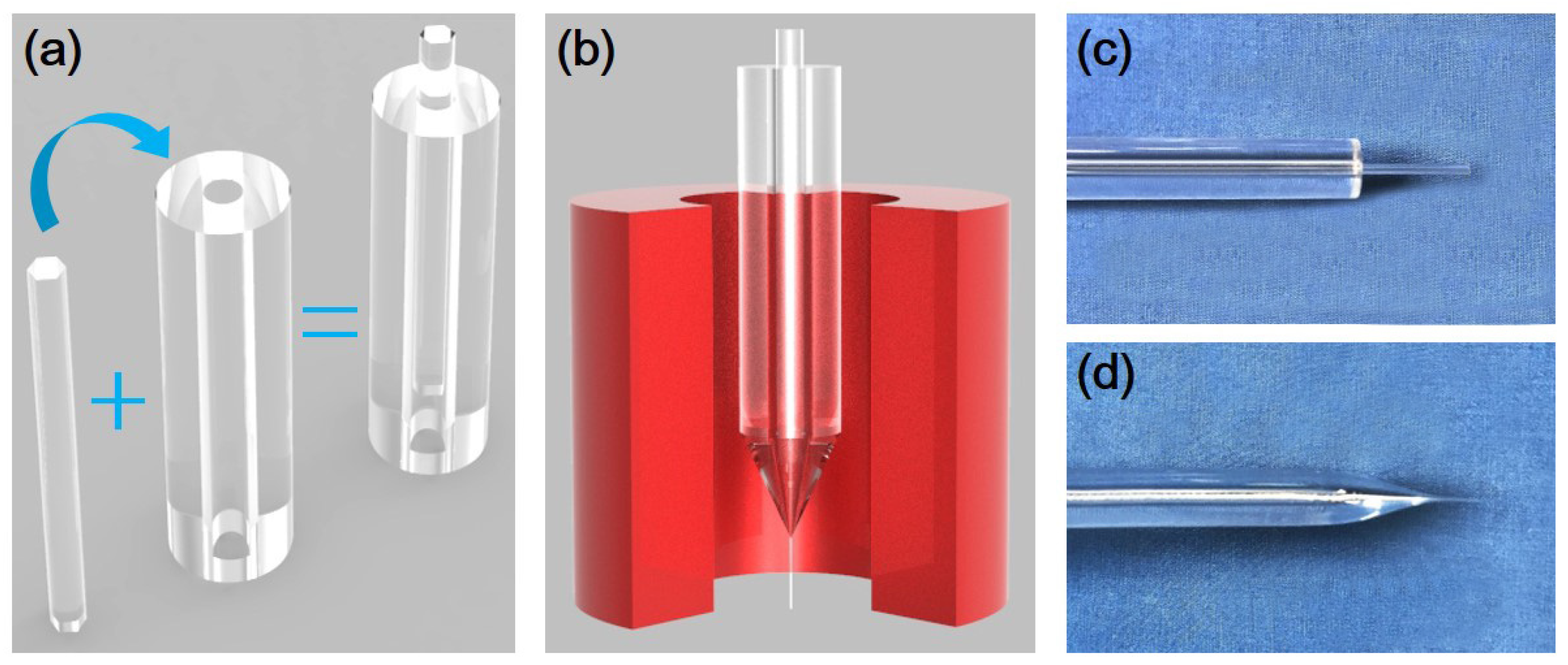



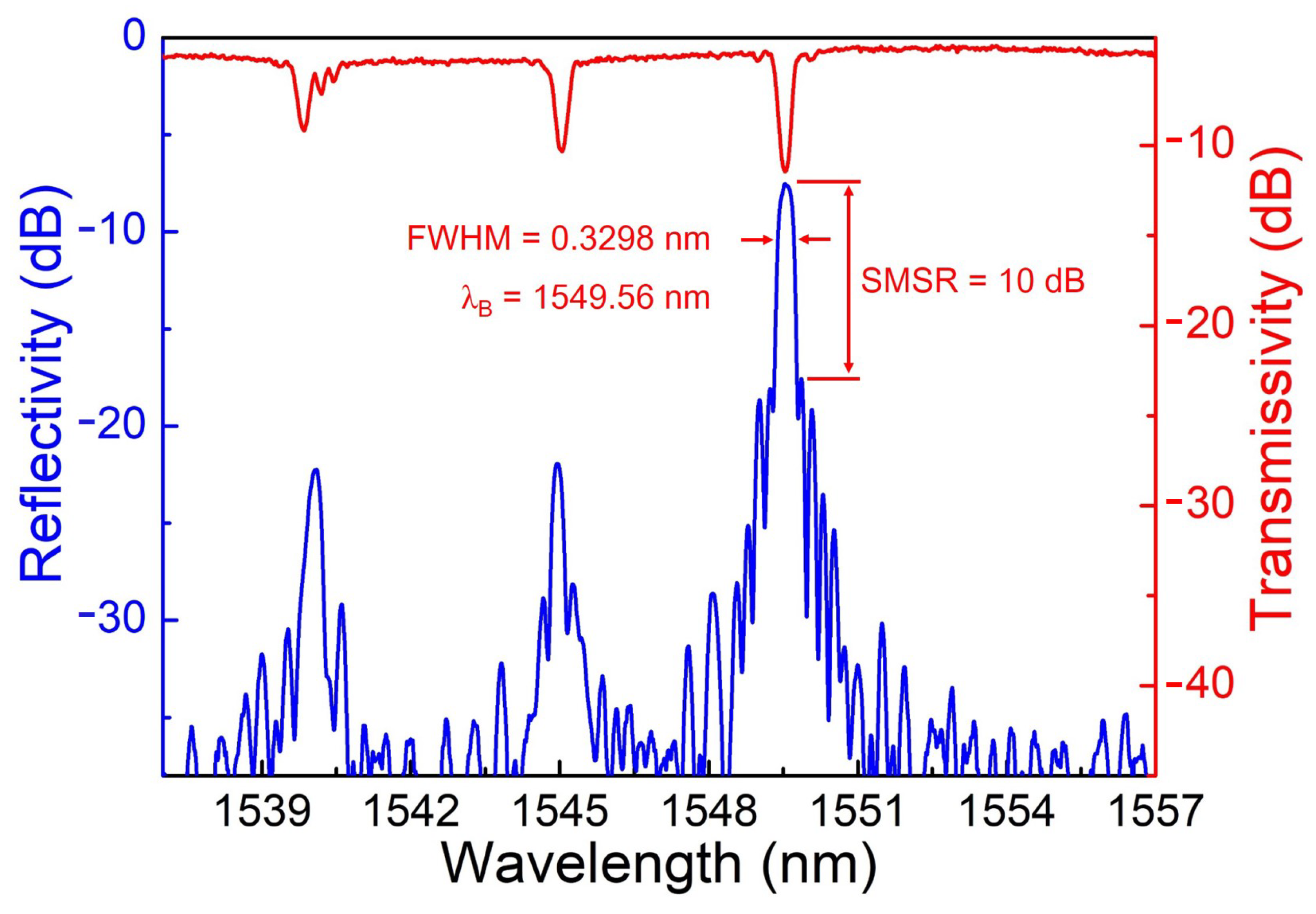
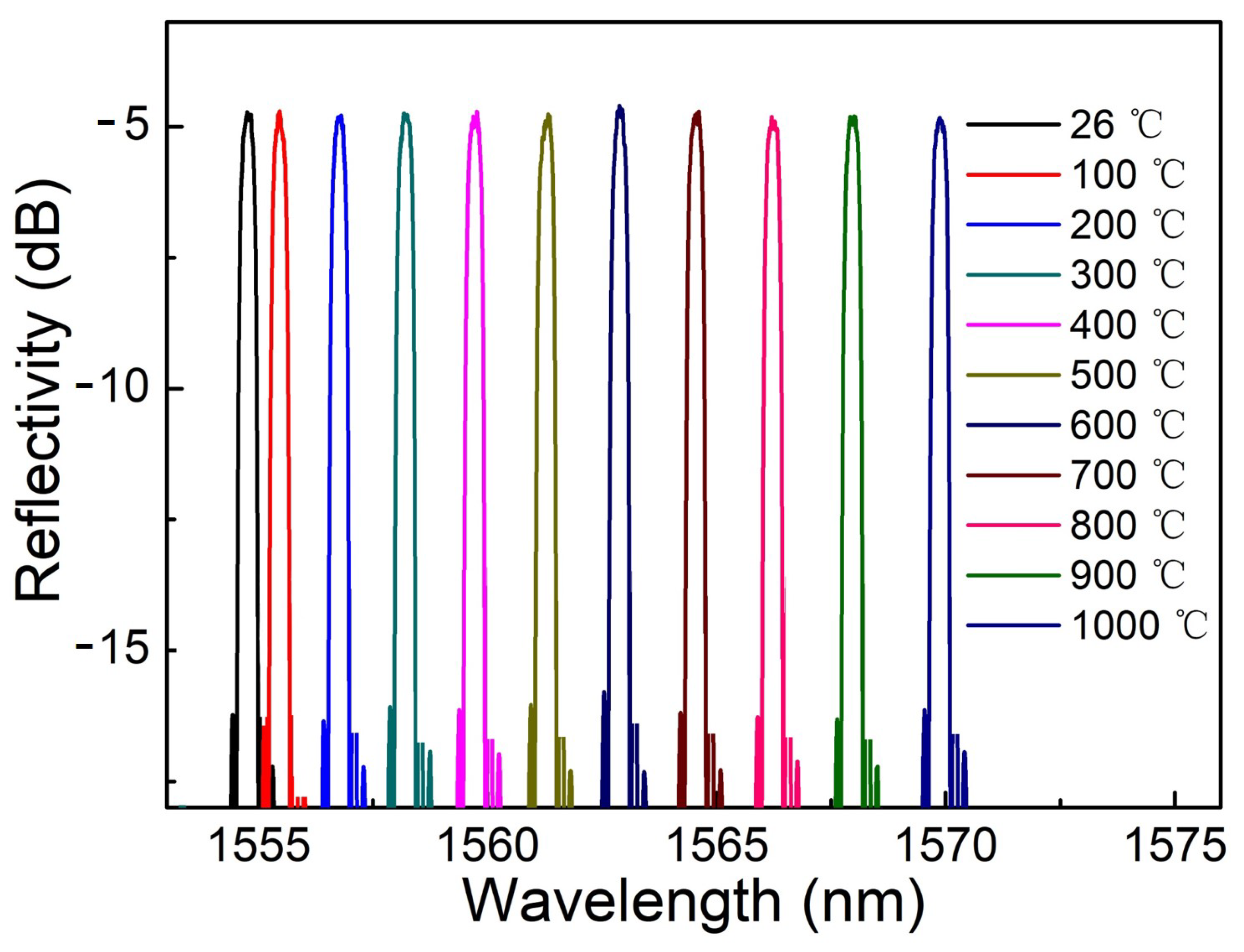
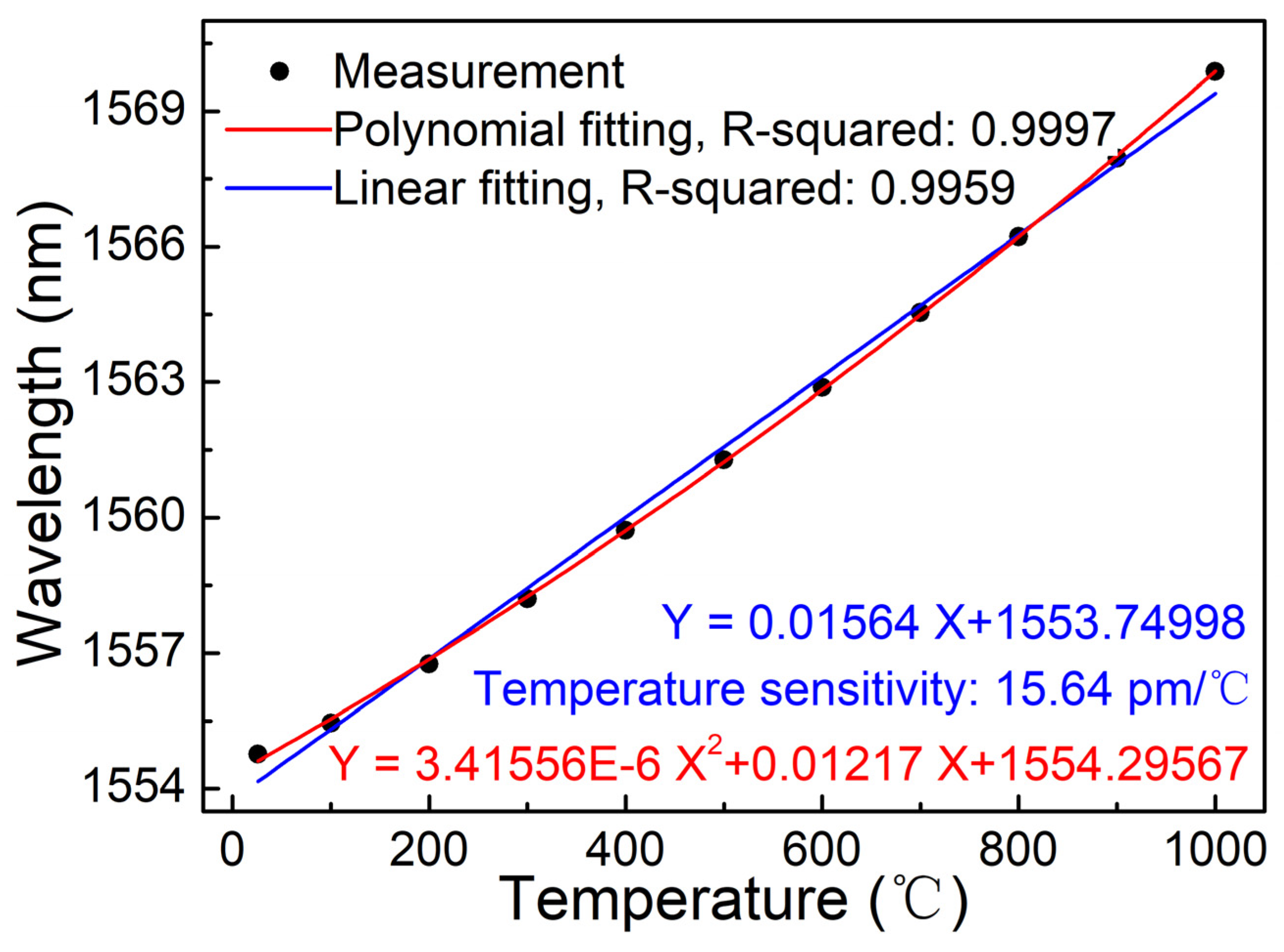
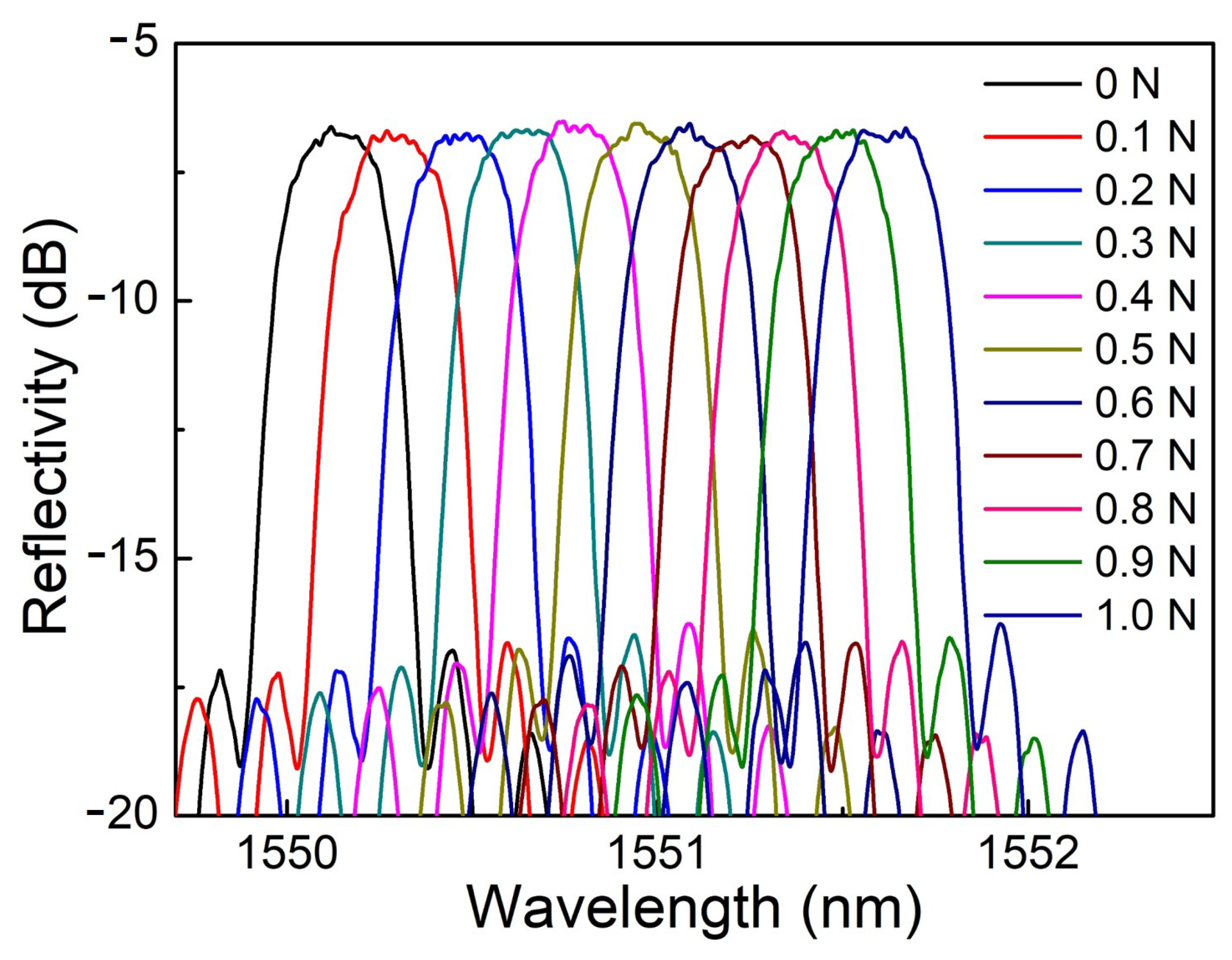
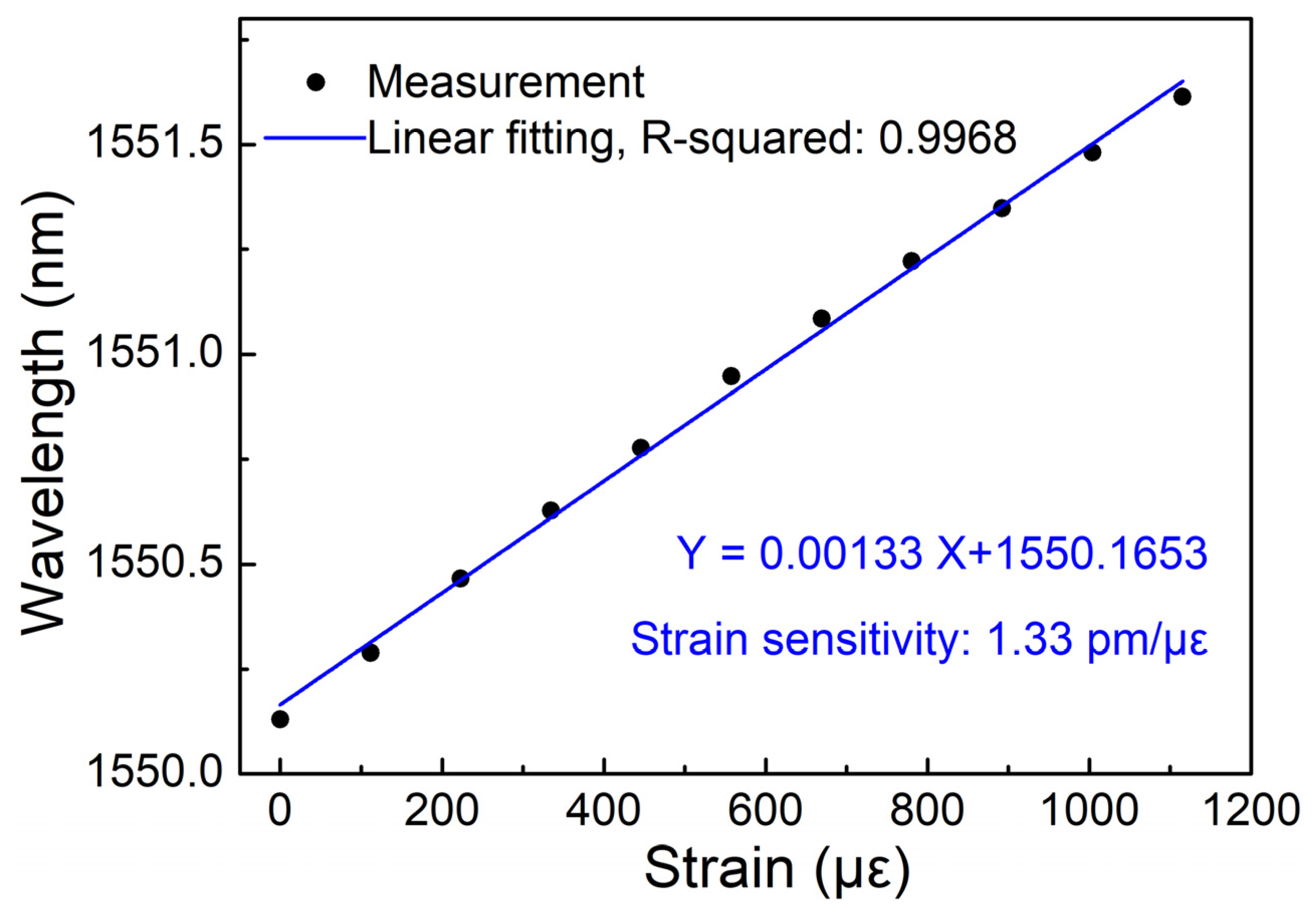
Publisher’s Note: MDPI stays neutral with regard to jurisdictional claims in published maps and institutional affiliations. |
© 2021 by the authors. Licensee MDPI, Basel, Switzerland. This article is an open access article distributed under the terms and conditions of the Creative Commons Attribution (CC BY) license (https://creativecommons.org/licenses/by/4.0/).
Share and Cite
Guo, Q.; Jia, Z.; Pan, X.; Liu, S.; Tian, Z.; Zheng, Z.; Chen, C.; Qin, G.; Yu, Y. Sapphire-Derived Fiber Bragg Gratings for High Temperature Sensing. Crystals 2021, 11, 946. https://doi.org/10.3390/cryst11080946
Guo Q, Jia Z, Pan X, Liu S, Tian Z, Zheng Z, Chen C, Qin G, Yu Y. Sapphire-Derived Fiber Bragg Gratings for High Temperature Sensing. Crystals. 2021; 11(8):946. https://doi.org/10.3390/cryst11080946
Chicago/Turabian StyleGuo, Qi, Zhixu Jia, Xuepeng Pan, Shanren Liu, Zhennan Tian, Zhongming Zheng, Chao Chen, Guanshi Qin, and Yongsen Yu. 2021. "Sapphire-Derived Fiber Bragg Gratings for High Temperature Sensing" Crystals 11, no. 8: 946. https://doi.org/10.3390/cryst11080946
APA StyleGuo, Q., Jia, Z., Pan, X., Liu, S., Tian, Z., Zheng, Z., Chen, C., Qin, G., & Yu, Y. (2021). Sapphire-Derived Fiber Bragg Gratings for High Temperature Sensing. Crystals, 11(8), 946. https://doi.org/10.3390/cryst11080946








